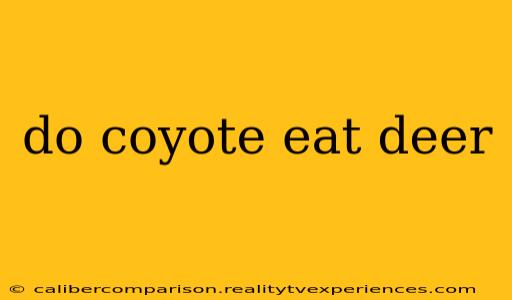Coyotes are opportunistic predators with a surprisingly diverse diet. While they're known for targeting smaller prey like rabbits and rodents, the question of whether they eat deer is a complex one, demanding a closer look at their hunting strategies, deer vulnerability, and the environmental factors at play. The short answer is: yes, but it's not their typical meal.
Coyote Hunting Strategies: Size Matters
Coyotes are relatively small canids, typically weighing between 20 and 50 pounds. This size limitation significantly impacts their hunting capabilities. Taking down a fully grown adult deer is a challenging feat, even for a pack of coyotes. Their hunting success depends heavily on several factors:
Targeting Vulnerable Deer:
- Fawns: Young, inexperienced deer fawns are the most likely victims. Their smaller size and lack of agility make them easier targets for coyotes. A lone coyote or even a small pack could successfully ambush and kill a fawn.
- Sick or Injured Deer: Coyotes are adept at detecting weakness. A deer already weakened by disease, injury, or old age presents a significantly easier prey target.
- Deer in Distress: A deer caught in a difficult situation, such as being trapped or stuck in deep snow, becomes vulnerable to coyote predation.
Pack Hunting: Increasing the Odds:
While a single coyote might attempt to prey on a fawn, a pack of coyotes working together dramatically increases their hunting success rate. By coordinating their efforts, they can overwhelm and subdue even larger, healthier deer, particularly if the deer is already stressed or injured.
Environmental Factors: Influence on Prey Selection
The environment plays a significant role in influencing coyote hunting behaviors and prey selection. Factors like:
- Habitat: Areas with dense vegetation or limited escape routes for deer can increase the likelihood of successful coyote attacks.
- Food Availability: When other, more readily available prey sources are scarce (e.g., during harsh winters or periods of drought), coyotes might resort to hunting larger prey like deer, especially fawns.
- Coyote Population Density: High coyote populations can lead to increased predation pressure on deer populations.
The Role of Coyotes in the Ecosystem
It's important to understand that coyotes, as apex predators in many ecosystems, play a crucial role in maintaining a healthy balance. While they can prey on deer, their impact on adult deer populations is generally less significant than other factors such as habitat loss, disease, and hunting by humans. Their predation on fawns, however, can have an influence on deer population dynamics.
Conclusion: A Complex Relationship
In conclusion, while coyotes don't routinely prey on adult deer, they are opportunistic predators capable of killing deer under specific circumstances. Vulnerable deer, like fawns, sick individuals, or those in distress, are most susceptible to coyote attacks. The interplay between coyote hunting strategies, deer vulnerability, and environmental conditions ultimately dictates the frequency of coyote predation on deer within any given ecosystem. Understanding this complex relationship is essential for appreciating the intricate dynamics of wildlife populations.

